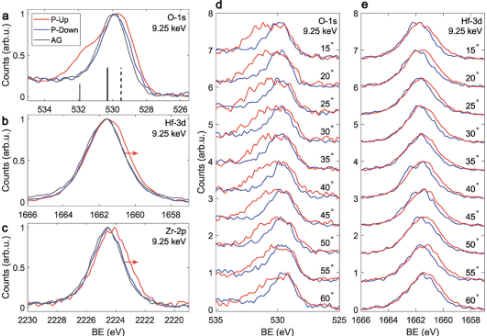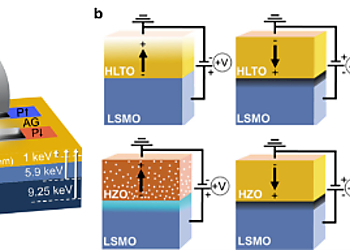Depth‐Resolved X‐Ray Photoelectron Spectroscopy Evidence of Intrinsic Polar States in HfO2‐Based Ferroelectrics
Result of the Month
Hf0.88La0.04Ta0.08O2 (HLTO) was measured using photoelectron spectroscopy at 1 keV and 5.9 keV at the I-09 beamline at Diamond Light Source to access both surface and buried interfacial chemistry. Using a lab-based Ga-kα X-ray source at 9.25 keV, angle-resolved HAXPES was performed on Hf0.5Zr0.5O2 (HZO) to probe various depths of the device. These measurements were preformed on as-grown (AG) regions of the film as well as regions that were up- or down-polarized using piezoresponse force microscopy (PFM). Comparison of different poling conditions for two different ferroelectric films provided insights into the relationship between ferroelectric polarization and electrochemical behaviour within the device.
The surprising difference between the HLTO and HZO device stacks lies in the redox reaction exhibited by HZO upon electric field application, while HLTO does not show such behaviour. Our observations reveal that HLTO, which has a higher polarization than HZO, undergoes significantly less electrochemical modification upon electric-field application causing polarization switching.
We find that the electric field drives oxygen reorganization, with the material chemistry and charge state, as well as the device structure, determining the resulting changes. This work points to a lesser significance of oxygen reorganization in the single-cycle performance of hafnia-based ferroelectrics and provides evidence for the intrinsic nature of polar states in HfO2-based ferroelectrics.

HAXPES measurements on HZO performed using a Ga Kα (9.25 keV) metal jet source in the Henry Royce Facility of the Photon Science Institute at the University of Manchester. Image 2 shows the photoelectron spectra collected: a) O-1s, b) Hf-3d, and c) Zr-2p spectra for P-up (red line), P-down (blue line), and as grown (grey line) PFM conditions. O-1s peaks marked: (Hf/Zr)-O (solid line), NL-O (dotted line), and La-O (dashed line). Core-level shifts are highlighted by red arrows. d,e) Angular cuts through the electron detector, moving from the shallowest electron escape depth (15°) to the deepest escape depth (60°) for (d) O-1s and (e) Hf-3d.
Angle resolved HAXPES measurements allowed us to identify the depth dependence of the non-lattice oxygen species (O-1s shoulder at 531.9 eV), revealing a uniform presence of NL-O throughout the HZO film. This is consistent with previous observations of HZO redox upon ferroelectric switching, but inconsistent with our observations in HLTO. This provides critical evidence towards an intrinsic ferroelectric state in HfO2 films, as HZO presents more electrochemical reorganization of oxygen despite its lower remnant polarization, as compared to HLTO.

